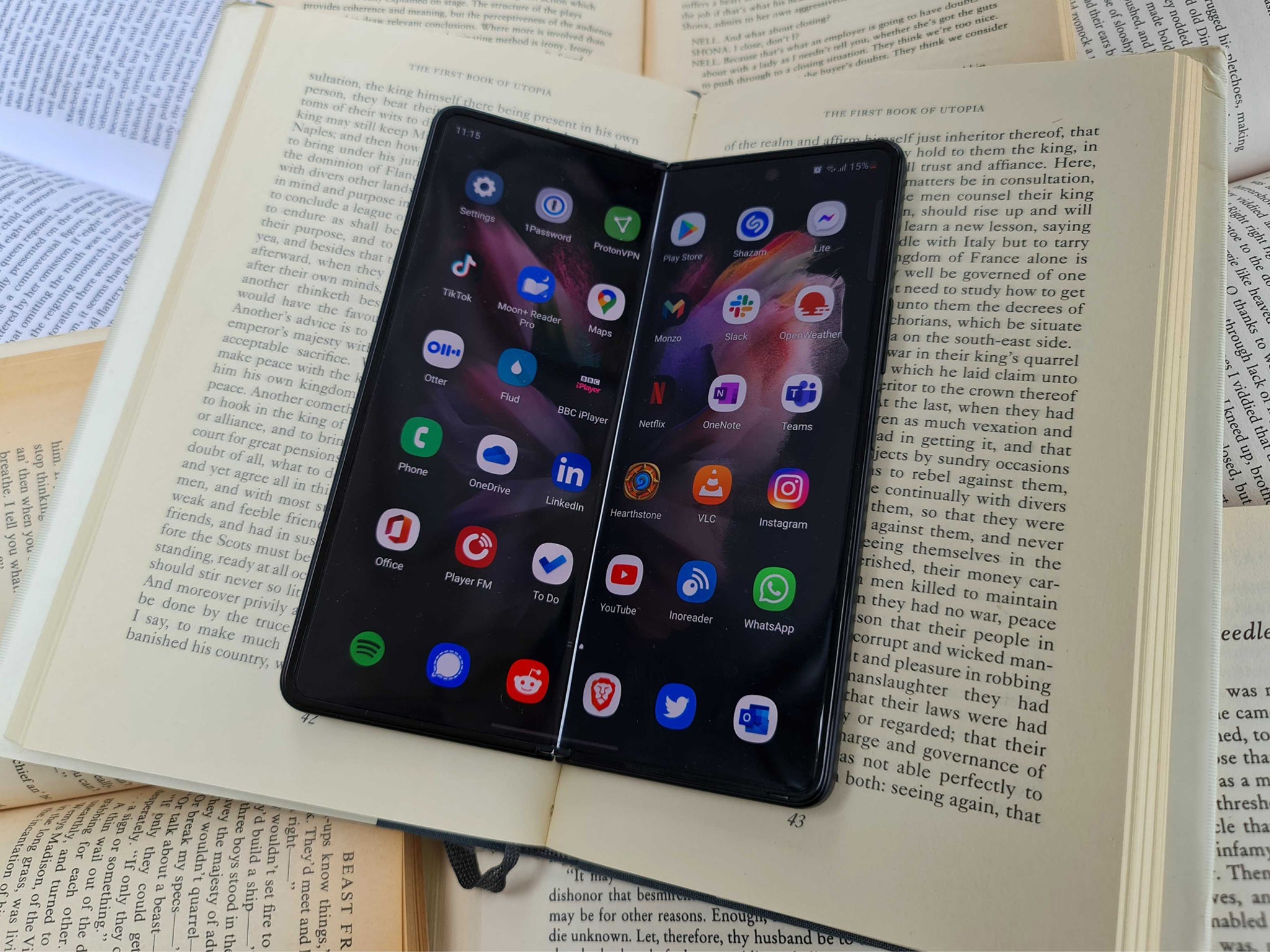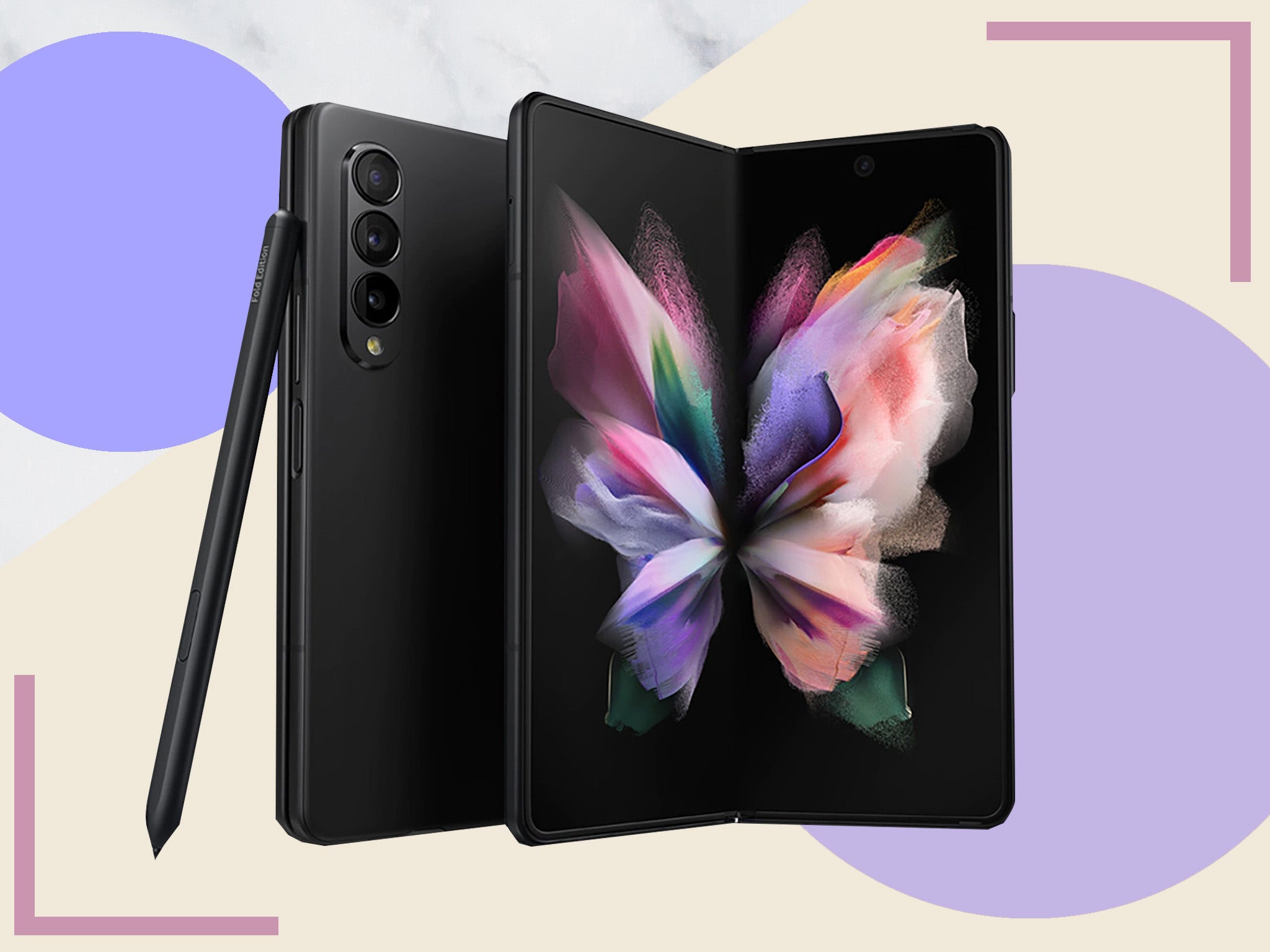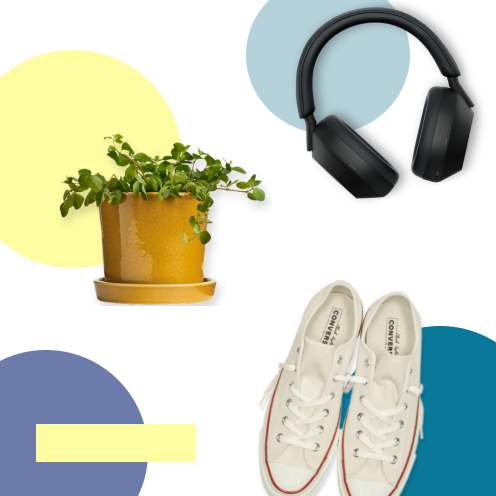Samsung Galaxy Z Fold 3

Buy now £1599, Samsung.com
- Weight: 271g
- Dimensions (folded): 67.1mm x 158.2mm x 16mm
- Dimensions (unfolded): 128.1mm x 158.2mm x 64mm
- Display: 6.2in external, 7.6in internal
- Battery: 4400mAh, one day of battery life
- Camera (rear): 12MP f/1.8 wide-angle, a 12MP f/2.2 ultra-wide, 12MP f/2.4 telephoto lens
- Camera (front): 10MP f/2.2
- Camera (internal): 4MP f/1.8
- Storage: 256GB/512GB built-in
- Memory: 12GB (RAM)
- Rating: 7/10
Design
When closed, the Z Fold 3 is long and thin, a closer companion to some of Sony’s Android devices than Samsung’s Galaxy Note ones. It feels more compact than other conventional smartphones – for both good and ill, as it can be difficult to type on such a narrow screen, and some may prefer it to be a bit wider – although Samsung says that this difference was the optimum size for both comfort and the aspect ratio of the internal screen.
At the top of the 2260 x 216px screen – which has an impressive 120Hz adaptive refresh rate for smoother animations and responsive gaming – is a 10MP f/2.2 front-facing camera for quick snaps and face unlock. At the bottom is a USB-C port for charging. On the left side is the hinge, which has been reinforced to make it IPX8 waterproof (1.5 meter depth for up to 30 minutes) but not dustproof, because there is no way to fully seal the device. Samsung instead uses tiny nylon brushes to keep tiny debris out.
Read more: Realme GT review: A high-tech budget smartphone that’s sure to turn heads
We have not used the phone long enough to see whether that durability stands up over long-term use, but it is a priority for the company following the infamous recall of the first Fold. Samsung claims the device can be opened and closed 200,000 times, but the challenges of making this feat of engineering mean that if it breaks, it’s difficult to repair. The company offers an extended warranty on the phone and, in this instance, buyers should consider taking it.
The Z Fold 3, although still hefty, is lighter than its predecessor at just 271g rather than 282g. It feels solid and the back is sleek, feeling good in the hand. Opening the device is a two-handed job and does feel like using a small tablet rather than a big smartphone but feels natural. The fingerprint scanner, located on the right-hand side also works well, although larger hands may wish it had swapped places with the higher-up volume keys.
Display
The main display users will be looking at is the 7.6in 2208 x 1768px AMOLED one. It also has a 120Hz adaptive refresh rate, made of polyethylene terephthalate (PET) plastic that is stronger and resists scratches better than previous models. It’s bright and punchy with good handling of colours and is useful when watching YouTube videos, reading eBooks, and so on.
There is a visible crease in the middle of the screen, and you can feel it when running your finger over it, but most of the time your fingers won’t be touching it. And, much like hole punch notches, eventually it adapts quickly to its presence.
Read more: 8 best screen protectors to keep your device looking brand new
At the top of the right-hand screen is another camera, a 4MP f/1.8 under-display camera for taking video calls. Rather than make this a simple cut-out, Samsung added a layer of LEDs that copy the surrounding pixels to make it less visible. But while the camera is harder to spot when someone else is using the phone, it remains quite visible when holding it; like looking at something through a mesh screen door.
Both the main display and the outer display support Samsung’s S Pen stylus (£44, Samsung.com), but not the one found on previous Note devices due to a risk of damaging the screen. Instead, users will need to pick up the new S Pen Fold or Pro (£99, Samsung.com), which slots into an optional phone case rather than inside the phone’s body akin to the Note range. Unfortunately, Samsung did not provide us with a stylus to test, but in a brief hands-on, the pen appeared to work decently.
Performance
When not passively consuming content, the large display (which is essentially a side-by-side dual-screen phone) can be used in a number of ways. Apps that have been updated, like WhatsApp, will display its main screen, a list of chats on the left and the one the user has selected on the right. Or the Camera app will show the viewfinder on the right and a list of recently-taken photos on the left.
Samsung says that 100 of the most-used apps will be optimised for large-screen use by the time the device is launched on 27 August. Those included will be; Amazon, Google Meet and Maps, Teams, Netflix, Twitch, Twitter, YouTube, and Zoom – many of which were not available when we tested it.
Some apps like Instagram and TikTok load in the middle of the two screens and have large black bars along the right and left to fill the empty space. Samsung said that both of those apps will be getting updates, but users may have to wait for longer until more niche software is properly optimised for a multi-window experience.
Read more: 8 best phone tripods that help capture your best side
Don’t let that completely write off their usability; one of the best ways to use this device is with one app running on the left and another on the right. Samsung has made its Edge Panel pinnable to the right-hand side, so it looks like the Taskbar on Windows 10 (or the Dock on a Mac), for quickly switching between the most-used apps which is incredibly useful. The Z Fold 3 has 12GB of ROM and 256GB of RAM (or 512GB for an extra £100), and apps load snappily with no issue.
This power really comes into its own with software like Xbox Game Pass – putting the Z Fold 3 into landscape mode, pairing it with a controller, and using the larger screen’s real estate to play games like Hellblade: Senua’s Sacrifice with ease. This is the dream of the device: rather than having to take my tablet with me, or endure playing on a small screen, the Z Fold 3 is small, or big, depending on what I need it to be.
Putting it on its back and folding one side of the screen upwards like a laptop also works well – and is more convenient than having to stack a conventional phone against a makeshift stand. There’s a future where users pair this phone with Bluetooth keyboards and it becomes a decent enough word processor, rather than having to carry a laptop around. But while such things are tangible, they’re not quite practical yet.
It’s these kinds of use cases where other manufacturers, including, and perhaps most importantly, Apple, simply cannot compete yet. Samsung’s UK Corporate Vice President, Conor Pierce, says that 25 per cent of people buying Galaxy Z Fold devices come from previously having used competitors devices, seeking the kind of next-generation tech that other companies can’t match yet.
Read more: 9 best 5G phones for next-generation speeds
That still might not be a lot, though. Samsung reportedly plans to sell 6.5 million foldable devices globally in 2021. That’s a large number, but it pales in comparison to the 90 million iPhones sold in Apple’s fourth quarter alone. With the Cupertino company generally dominating the premium market, Samsung still has some significant catching up to do.
Battery life
The Galaxy Z Fold 3 has a 4400mAh battery, which Samsung says should last “all day” (but did not give an estimate in terms of hours) but is less than the 5000mAH battery that’s found in the Samsung Galaxy S21 Ultra (£1,329, Samsung.com).
“Based on our research, we know our customers wanted an enhanced main screen experience, and a slimmer body for portability. Therefore, we made the decision to optimize the battery size in order to prioritise the device structure”, Samsung told The Independent.
The battery in the Z Fold 3 lasted most of the day but usually required a boost towards the evening. It’s hard to say, however, whether this would be the same when it was not under a testing environment.
Read more: Best phones 2021: iPhone, Samsung and Huawei smartphones reviewed
When reviewing the device, we used it much more than we would normally, as we were trying out multiple strange combinations of apps, streaming video more often, and running high-intensity programs. So, it is likely that the battery drained much faster than it would under general use.
That said, it’s also possible there’s a psychological element: opening the phone to reply to a quick text, using the large screen because it’s a novelty and because the phone encourages you to do so. Either way there’s enough juice in this foldable device that one shouldn’t be too concerned with high-intensity use, but will want to ensure they start every day with a full battery just in case.
Cameras
The main camera on the back of the Z Fold 3 is made up of three lenses: a 12MP f/1.8 wide-angle, a 12MP f/2.2 ultra-wide and a 12MP f/2.4 telephoto lens. Neatly, this can also be used as a selfie camera; when the phone is opened fully, the outer display can be used as a viewfinder. Holding a hand up starts a countdown before the photo is taken, rather than trying to fiddle about finding the shutter.
Although this is Samsung’s most expensive phone, it is not the most expansive camera setup. The S21 Ultra features a 108MP wide-angle, an ultra-wide, and two telephoto lenses, for a few hundred pounds less.
Read more: Can Motorola’s moto G50 deliver a high-end smartphone experience for under £200?
There will be some people that want this device to be the top of Samsung’s line in every spec, and that is understandable. But, Samsung’s mission with the Fold and Flip devices is to make foldables mainstream, and no doubt such a device will come when the form factor is on more stable ground.
Moreover, these are devices that do very different things for very different people and in our quick testing, the Z Fold 3 takes good photos without complaint. It does not feel like a prospective user of this foldable phone would prioritise the camera – or even necessarily the smoothest user experience or convenience – and with its not inconsiderable price tag it’s likely they could also afford a decent DSLR as well.
The verdict: Samsung Galaxy Z Fold 3
What will push people towards the Galaxy Z Fold 3 – rather than an easier-to-use iPhone or other Android device, is a taste of Samsung’s future.
Being on the edge of what Samsung believes is the next stage of smartphones sometimes means being left off-balance. But, for some, the thrill of using something that only a (relatively) small handful of people will use has its own excitement.
It feels like Samsung is closer than ever to a big-screen foldable device made for the normal user. The price drop, while not enough compared to more conventional phones, makes the device appear more reasonable – especially next to the sub-£1000 Galaxy Z Flip 3 (£949, Samsung.com) expanding the foldable market. The optimisation problems that still bug the Fold intermittently are now on the software side rather than hardware, and Samsung says that a lot of those will be fixed by the time the Z Fold 3 is in consumer’s hands.
For the user, it all depends on if that large, luxurious screen are worth that compromise – and how long such compromises will even exist. Foldable phones may still go the way of the 3D TV, and having only used it a week it’s hard to judge the long-term cultural impacts of this relatively new product. But for those with the money to spend, who can afford the risks, Samsung has made its most compelling argument for an executive foldable phone yet.

